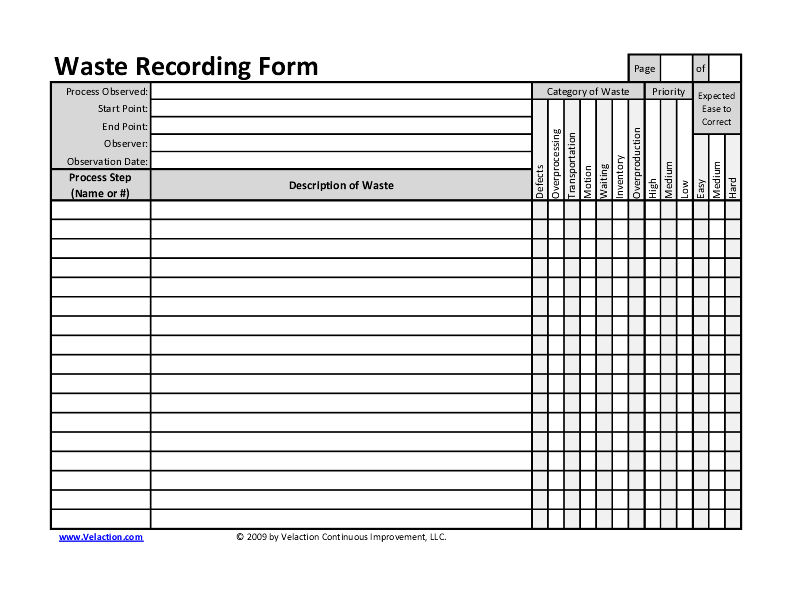🛠 > Lean Forms & Tools Directory > Download Free Forms & Tools
Waste Recording Form
The waste recording form is a simple tool for documenting waste during a process walk.
The observer focuses on identifying the wasteful activities a person is performing and records them on the form. The form will usually contain a place to categorize the waste.

Waste reduction is a large part of kaizen.
The obvious first step in reducing waste is to identify it. That is the benefit of using a waste recording form. It provides the observer with a standardized tool to systematically observe a process with an eye towards waste.
The most common time a waste recording form is used is during the process walk phase of a kaizen event.
Normally, each person on the team will be assigned a role. Any people not part of the team documenting process steps or measuring cycle times will often be assigned the task of recording waste. The more people doing this, the better. Each wasteful activity the team identifies provides one more opportunity to improve the operation.
The steps to complete a waste recording form include:
Fill out the header information.
- Process Observed: Document the common name of the process so people will know what the sheet covers.
- Start and End Points: Establish boundaries of what the waste recording form covers.
- Observer: Knowing who recorded the information lets other people ask for clarification.
- Observation Date: Things change. Knowing when the form was recorded lets the reader understand the circumstances.
- Page X of Y: Use this block to indicate if multiple pages are used. It is common to fill several pages while doing a process walk.
Observe the process. At this point, refrain from asking questions. Use your eyes and your ears to identify inefficiencies. If you don’t understand what is happening, and really want to ask the operator something, keep it brief. You don’t want the operator biasing your observation.
- Note the process step by name, or by number if it is already documented.
- Describe the waste in a way that you can recall later. Recording waste can feel rushed, but documenting something illegibly, or that you can’t understand later doesn’t help.
- Check which type of waste you observed. Don’t worry too much about getting it “correct”. The categories are just a tool to help inspire the observer.
- Mark a priority. This is a judgment call of how much of an impact the waste is.
- Mark the expected ease to correct. Try not to think of solutions just yet, but some problems just seem easier than others to resolve. This block and the priority will help you identify the highest value projects to spend resources on.
Repeat. You may have to repeat the observation several times until you don’t see any new wastes. You will seldom see everything the first time through. Keep observing the process until you see very few new items of waste.

0 Comments